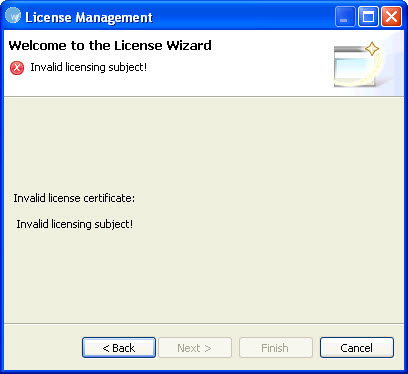
This section includes a list of common errors, their cause and steps that you can follow to solve them.
Problem: Error message: Invalid license certificate

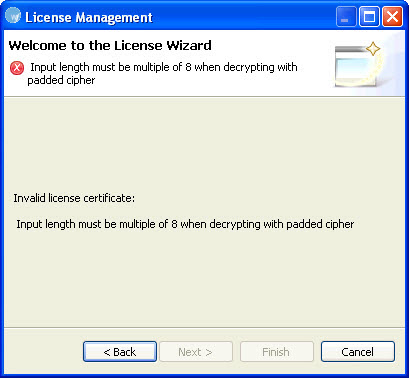

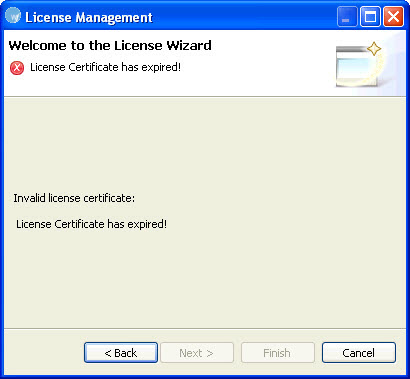
Cause: These error messages appear due to the following reasons:
License certificate is not a Wordfast Pro 3 license certificate
License certificate has an incorrect file name or user name
License certificate is edited or some information is missing from the file
License certificate has expired
Solution: Contact the administrator for a new license certificate. You can contact the administrator by logging into the Wordfast Pro 3 support hotline at www.wordfast.com.
Problem: Error message: TXML source files missing

Cause: The TXML file and the original file are not at the same location or do not have the same file name.
Solution: Ensure that the TXML files and the original files are at the same location. If not, the cleanup process cannot be completed.
Problem: Error message: Translation memory header is invalid

Cause: The local TM file that is being opened does not have the correct header, which typically includes the creation date, user ID, source and target language and so on.
Solution: Ensure that the correct local TM is opened. If the error persists, please log into the Wordfast Pro 3 support hotline at www.wordfast.com.
Problem: Error message: Terminology skipped during import
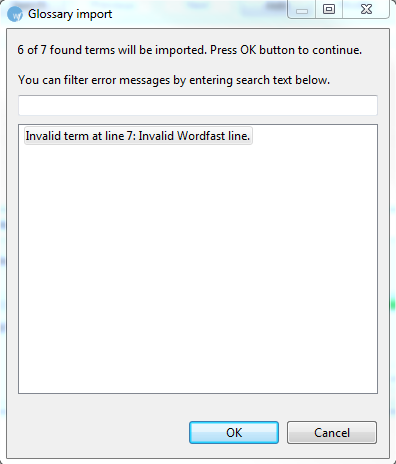
Cause: The source or target segment is missing from the glossary.
Solution: Ensure that the imported glossary contains the source and target segments of all the terms.
Problem: Error message: Unable to connect to remote TM
Cause: The URL to the remote TM server is incorrect or invalid.
Solution:
Go to Edit > Preferences > Translations > Translation Memory > TM List.
Check if the remote TM URL is correct. This is an example of a URL string: wf://french_user:french_password@63.246.29.190:47110
Check if there are trailing spaces at the end.
Problem: Error message: Current project and local TM have different source and target languages
Cause: The source and target languages associated with the currently open project does not match the local TM language pair.
Solution:
Go to Edit > Preferences > Translations > Translation Memory > TM List.
Select the local TM and click Edit TM.
Change the source and target languages to match the current project language pair.
Problem: Error message: Current project and remote TM have different source and target languages

Cause: The source and target languages associated with the currently open project does not match the remote TM language pair.
Solution:
Go to Edit > Preferences > Translations > Translation Memory > TM List.
Select the remote TM and click Edit TM.
Change the source and target languages to match the current project language pair.
Problem: Error message: Current project and file for translation have different source and target languages.
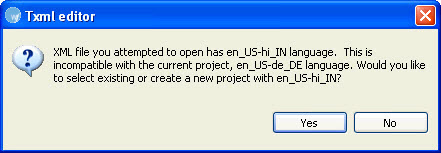
Cause: The source and target languages associated with the currently open project does not match the file language pair.
Solution 1: Check that you are opening the correct file. If necessary, open the file in a text editor and view/verify the source and target language specifications.
Solution 2: Create a new project with source and target languages matching the file for translation. Go to Creating a project for more information.
Problem: Error message: Current project and
selected Glossary do not have the same source and target language code

Cause: The source and target languages associated with the currently open project does not match the glossary pair.
Solution:
Go to Edit > Preferences > Translations > Terminology > Glossary List.
Select the glossary and click Edit.
Change the source and target languages to match the current project language pair.
Problem: Translation Memory is not leveraged during translation
Cause: A local or remote TM is not selected.
Solution: Ensure that you are connected to a TM. To confirm go to Translation Memory > New/Select TM > Local or Remote and check the Selected check box next to the TM you wish to use. If you have Read only selected, you will not be able to leverage or copy into the TM.
Problem: Shortcut keys not working for key strokes
Cause: The correct scheme is not selected or the shortcut key is not configured.
Solution:
Go to Edit > Preferences > General > Shortcut Keys > Scheme.
Choose the correct scheme: Wordfast Pro 3, Emacs, SDLX, Trados, Wordfast or Wordfast Classic.
Check the shortcut key list to ensure that all shortcut keys are configured correctly. If not, edit accordingly. Go to Managing shortcut keys for more information on viewing, modifying and creating shortcut keys.
Click Apply and OK.